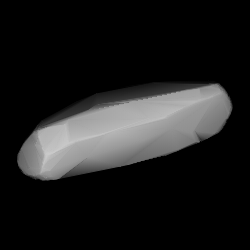Highly elongated background asteroid
2156 Kate (prov. designation A917 SH ) is a highly elongated background asteroid from the inner regions of the asteroid belt . The asteroid was discovered on 23 September 1917, by Soviet–Russian astronomer Sergey Belyavsky at the Simeiz Observatory on the Crimean peninsula.[ 10] [ 2] S-type /A-type asteroid has a rotation period of 5.6 hours and measures approximately 8 kilometers (5.0 miles) in diameter.
Orbit and classification
Kate orbits the Sun in the inner main-belt at a distance of 1.8–2.7 AU once every 3 years and 4 months (1,226 days). Its orbit has an eccentricity of 0.20 and an inclination of 5° with respect to the ecliptic .[ 1] precoveries were taken, and no prior identifications were made, the asteroid's observation arc begins with its official discovery observation at Simeiz in 1917.[ 10]
Naming
This minor planet was named after Kate Kristensen, wife of astronomer L. K. Kristensen, who was involved in the body's orbit computation.[ 2] Minor Planet Center on 1 April 1980 (M.P.C. 5284[ 11]
Physical characteristics
In the Tholen classification , Kate is a common S-type asteroid .[ 1] A-type asteroid by Pan-STARRS ' large photometric survey.[ 9]
Rotation period
Lightcurve -based 3D-model of Kate A large number of rotational lightcurves were obtained from photometric observations. They gave a well-defined rotation period of 5.620 to 5.623 hours with a brightness variation between 0.5 and 0.9 magnitude (U=3/3- [ 6] [ 7] [ 8] [ a]
Diameter and albedo
According to the survey carried out by the NEOWISE mission of NASA's space-based Wide-field Infrared Survey Explorer , Kate measures 8.131 kilometers in diameter and its surface has an albedo of 0.189 and 0.2242, respectively,[ 3] [ 4] Collaborative Asteroid Lightcurve Link assumes a standard albedo for stony asteroids of 0.20 and calculates a diameter of 8.61 kilometers with an absolute magnitude of 12.69.[ 5]
Notes
References
^ a b c d e f g h "JPL Small-Body Database Browser: 2156 Kate (A917 SH)" (2017-05-05 last obs.). Jet Propulsion Laboratory . Retrieved 11 June 2017 .^ a b c Schmadel, Lutz D. (2007). "(2156) Kate". Dictionary of Minor Planet Names . Springer Berlin Heidelberg . p. 175. doi :10.1007/978-3-540-29925-7_2157 . ISBN 978-3-540-00238-3 ^ a b c d Mainzer, A.; Grav, T.; Masiero, J.; Hand, E.; Bauer, J.; Tholen, D.; et al. (November 2011). "NEOWISE Studies of Spectrophotometrically Classified Asteroids: Preliminary Results" . The Astrophysical Journal . 741 (2): 25. arXiv :1109.6407 Bibcode :2011ApJ...741...90M . doi :10.1088/0004-637X/741/2/90 . Retrieved 1 March 2016 . ^ a b c Masiero, Joseph R.; Mainzer, A. K.; Grav, T.; Bauer, J. M.; Cutri, R. M.; Dailey, J.; et al. (November 2011). "Main Belt Asteroids with WISE/NEOWISE. I. Preliminary Albedos and Diameters" . The Astrophysical Journal . 741 (2): 20. arXiv :1109.4096 Bibcode :2011ApJ...741...68M . doi :10.1088/0004-637X/741/2/68 . Retrieved 7 December 2016 . ^ a b c d "LCDB Data for (2156) Kate" . Asteroid Lightcurve Database (LCDB). Retrieved 1 March 2016 .^ a b Binzel, R. P.; Mulholland, J. D. (December 1983). "A photoelectric lightcurve survey of small main belt asteroids" . Icarus . 56 (3): 519– 533. Bibcode :1983Icar...56..519B . doi :10.1016/0019-1035(83)90170-7 . ISSN 0019-1035 . Retrieved 1 March 2016 . ^ a b Hanus, J.; Durech, J.; Broz, M.; Warner, B. D.; Pilcher, F.; Stephens, R.; et al. (June 2011). "A study of asteroid pole-latitude distribution based on an extended set of shape models derived by the lightcurve inversion method" . Astronomy and Astrophysics . 530 : 16. arXiv :1104.4114 Bibcode :2011A&A...530A.134H . doi :10.1051/0004-6361/201116738 . Retrieved 1 March 2016 . ^ a b Kryszczynska, A.; Colas, F.; Polinska, M.; Hirsch, R.; Ivanova, V.; Apostolovska, G.; et al. (October 2012). "Do Slivan states exist in the Flora family?. I. Photometric survey of the Flora region" . Astronomy and Astrophysics . 546 : 51. Bibcode :2012A&A...546A..72K . doi :10.1051/0004-6361/201219199 . Retrieved 1 March 2016 . ^ a b c Veres, Peter; Jedicke, Robert; Fitzsimmons, Alan; Denneau, Larry; Granvik, Mikael; Bolin, Bryce; et al. (November 2015). "Absolute magnitudes and slope parameters for 250,000 asteroids observed by Pan-STARRS PS1 - Preliminary results" . Icarus . 261 : 34– 47. arXiv :1506.00762 Bibcode :2015Icar..261...34V . doi :10.1016/j.icarus.2015.08.007 . Retrieved 1 March 2016 . ^ a b "2156 Kate (A917 SH)" . Minor Planet Center . Retrieved 1 March 2016 .^ "MPC/MPO/MPS Archive" . Minor Planet Center . Retrieved 20 May 2016 .
External links

